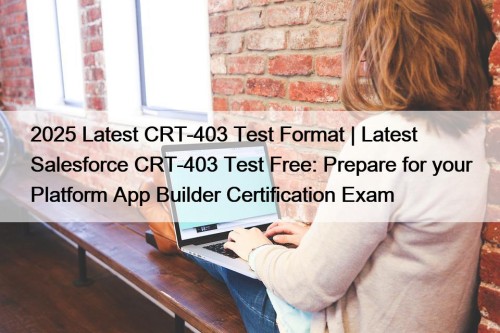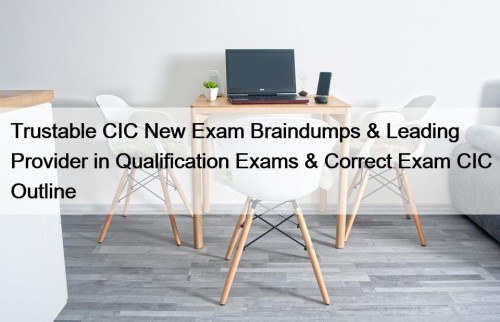Most Popular
 Intereactive ISOIEC20000LI Testing Engine & ISOIEC20000LI Reliable Dump
Intereactive ISOIEC20000LI Testing Engine & ISOIEC20000LI Reliable Dump
Three versions of ISOIEC20000LI study materials will be offered by ...
 2025 Latest CRT-403 Test Format | Latest Salesforce CRT-403 Test Free: Prepare for your Platform App Builder Certification Exam
2025 Latest CRT-403 Test Format | Latest Salesforce CRT-403 Test Free: Prepare for your Platform App Builder Certification Exam
Taking the Prepare for your Platform App Builder Certification Exam ...
 Trustable CIC New Exam Braindumps & Leading Provider in Qualification Exams & Correct Exam CIC Outline
Trustable CIC New Exam Braindumps & Leading Provider in Qualification Exams & Correct Exam CIC Outline
The only use of the internet is to validate the ...



Trustable CIC New Exam Braindumps & Leading Provider in Qualification Exams & Correct Exam CIC Outline

The only use of the internet is to validate the product license for the CIC practice exam software. If you are not online, you can still practice for the CBIC CIC exam questions thanks to this feature of 2Pass4sure's CIC Exam simulation software. As a result, the CIC desktop-based practice test software is a particularly useful option for customers who do not constantly have access to the internet.
Developing your niche is very easy in the presence of the CIC dumps. The credentials are not very difficult to achieve because like CIC the acclaimed vendors are highly successful in the industry. If you need a boost in your career, then 2Pass4sure is the site you have to opt for taking CIC Certification exams. Some of the vital features of the CIC dumps of 2Pass4sure are given below. CIC dumps are the most verified and authentic braindumps that are used to pass the CIC certification exam. The whole CIC study material is approved by the expert.
Free PDF 2025 CIC: Efficient CBIC Certified Infection Control Exam New Exam Braindumps
2Pass4sure also presents desktop-based CBIC CIC practice test software which is usable without any internet connection after installation and only required license verification. CBIC CIC practice test software is very helpful for all those who desire to practice in an actual CBIC Certified Infection Control Exam (CIC) exam-like environment. CBIC Certified Infection Control Exam (CIC) practice test is customizable so that you can change the timings of each session. 2Pass4sure desktop CBIC CIC practice test questions software is only compatible with windows and easy to use for everyone.
CBIC Certified Infection Control Exam Sample Questions (Q147-Q152):
NEW QUESTION # 147
The Infection Prevention and Control Committee is concerned about an outbreak of Serratia marcescens in the intensive care unit. If an environmental source is suspected, the BEST method to validate this suspicion is to
- A. use ATP system.
- B. obtain surface cultures.
- C. apply fluorescent gel.
- D. perform direct practice observation.
Answer: B
Explanation:
The correct answer is C, "obtain surface cultures," as this is the best method to validate the suspicion of an environmental source for an outbreak of Serratia marcescens in the intensive care unit (ICU). According to the Certification Board of Infection Control and Epidemiology (CBIC) guidelines, Serratia marcescens is an opportunistic gram-negative bacterium commonly associated with healthcare-associated infections (HAIs), often linked to contaminated water, medical equipment, or environmental surfaces in ICUs. Obtaining surface cultures allows the infection preventionist (IP) to directly test environmental samples (e.g., from sinks, ventilators, or countertops) for the presence of Serratia marcescens, providing microbiological evidence to confirm or rule out an environmental source (CBIC Practice Analysis, 2022, Domain II: Surveillance and Epidemiologic Investigation, Competency 2.2 - Analyze surveillance data). This method is considered the gold standard for outbreak investigations when an environmental reservoir is suspected, as it offers specific pathogen identification and supports targeted interventions.
Option A (apply fluorescent gel) is a technique used to assess cleaning efficacy by highlighting areas missed during disinfection, but it does not directly identify the presence of Serratia marcescens or confirm an environmental source. Option B (use ATP system) measures adenosine triphosphate (ATP) to evaluate surface cleanliness and organic residue, which can indicate poor cleaning practices, but it is not specific to detecting Serratia marcescens and lacks the diagnostic precision of cultures. Option D (perform direct practice observation) is valuable for assessing staff adherence to infection control protocols, but it addresses human factors rather than directly validating an environmental source, making it less relevant as the initial step in this context.
The focus on obtaining surface cultures aligns with CBIC's emphasis on using evidence-based methods to investigate and control HAIs, enabling the IP to collaborate with the committee to pinpoint the source and implement corrective measures (CBIC Practice Analysis, 2022, Domain II: Surveillance and Epidemiologic Investigation, Competency 2.3 - Identify risk factors for healthcare-associated infections). This approach is supported by CDC guidelines for outbreak investigations, which prioritize microbiological sampling to guide environmental control strategies (CDC Guidelines for Environmental Infection Control in Healthcare Facilities, 2019).
References: CBIC Practice Analysis, 2022, Domain II: Surveillance and Epidemiologic Investigation, Competencies 2.2 - Analyze surveillance data, 2.3 - Identify risk factors for healthcare-associated infections.
CDC Guidelines for Environmental Infection Control in Healthcare Facilities, 2019.
NEW QUESTION # 148
An infection control manager is training a new infection preventionist. In discussing surveillance strategies, which of the following types of hospital infection surveillance usually provides maximum benefit with minimum resources?
- A. Nursing care plan review
- B. Antibiotic monitoring
- C. High-risk patient focus
- D. Prevalence surveys
Answer: C
Explanation:
A high-risk patient focus maximizes benefits while minimizing resource use in infection surveillance.
Step-by-Step Justification:
* Efficiency of High-Risk Surveillance:
* Targeting ICU, immunocompromised patients, or surgical units helps detect infections where the risk is highest, leading to earlier interventions.
* Resource Allocation:
* Full hospital-wide surveillance is resource-intensive; focusing on high-risk groups is more efficient.
* Why Other Options Are Incorrect:
* B. Antibiotic monitoring:
* Important for stewardship, but not the primary focus of infection surveillance.
* C. Prevalence surveys:
* Snapshot data only; does not provide ongoing monitoring.
* D. Nursing care plan review:
* Less direct in identifying infection trends.
CBIC Infection Control References:
* APIC Text, "Surveillance Strategies for Infection Prevention".
NEW QUESTION # 149
Which of the following processes is MOST important for the infection preventionist (IP) to review when evaluating a third-party reprocessor for single-use devices?
- A. Review the facility's blueprints and policies.
- B. Ensure air and water cultures are performed regularly.
- C. Observe all steps for reprocessing.
- D. Obtain feedback from other IPs who use the reprocessor.
Answer: C
Explanation:
The correct answer is A, "Observe all steps for reprocessing," as this is the most important process for the infection preventionist (IP) to review when evaluating a third-party reprocessor for single-use devices.
According to the Certification Board of Infection Control and Epidemiology (CBIC) guidelines, the reprocessing of single-use devices (SUDs) by third-party entities must adhere to stringent infection control standards to ensure they are safe for reuse and do not contribute to healthcare-associated infections (HAIs).
Observing all steps-such as cleaning, disinfection, sterilization, packaging, and quality control-allows the IP to directly assess compliance with manufacturer instructions, regulatory requirements (e.g., FDA guidelines), and best practices (e.g., AAMI ST91) (CBIC Practice Analysis, 2022, Domain III: Infection Prevention and Control, Competency 3.3 - Ensure safe reprocessing of medical equipment). This hands-on evaluation is critical because any deviation in the reprocessing chain can compromise device sterility and patient safety.
Option B (review the facility's blueprints and policies) provides context about the physical layout and procedural framework, but it is a preliminary step that does not directly verify the reprocessing process's effectiveness. Option C (ensure air and water cultures are performed regularly) is important for monitoring environmental contamination risks, particularly in sterile processing areas, but it is a supportive measure rather than the primary focus of evaluating the reprocessor's core activities. Option D (obtain feedback from other IPs who use the reprocessor) offers valuable peer insights, but it is subjective and secondary to direct observation, which provides firsthand evidence of compliance and performance.
The priority on observing reprocessing steps aligns with CBIC's emphasis on ensuring the safety and efficacy of reprocessed medical devices, a key responsibility for IPs when outsourcing to third-party reprocessors (CBIC Practice Analysis, 2022, Domain III: Infection Prevention and Control, Competency 3.5 - Evaluate the environment for infection risks). This process enables the IP to identify specific weaknesses, validate adherence to standards, and make informed decisions about the reprocessor's suitability.
References: CBIC Practice Analysis, 2022, Domain III: Infection Prevention and Control, Competencies 3.3 - Ensure safe reprocessing of medical equipment, 3.5 - Evaluate the environment for infection risks. AAMI ST91:2015, Flexible and semi-rigid endoscope processing in health care facilities.
NEW QUESTION # 150
In the current year, cases of tuberculosis (TB) among foreign-born persons accounted for the majority of new TB cases in the United States. The number of states with greater than 50% of cases among foreign-born persons increased from four cases ten years ago to 22 cases in the current year. This information can BEST be used to
* heighten awareness among Emergency Department staff.
* inform staff who are foreign-born.
* educate patients and visitors.
* review the TB exposure control plan.
- A. 1 and 2 only.
- B. 3 and 4 only.
- C. 2 and 3 only.
- D. 1 and 4 only.
Answer: D
Explanation:
The correct answer is B, "1 and 4 only," indicating that the information can best be used to heighten awareness among Emergency Department (ED) staff and review the TB exposure control plan. According to the Certification Board of Infection Control and Epidemiology (CBIC) guidelines, tuberculosis (TB) remains a significant public health concern, particularly with the increasing proportion of cases among foreign-born persons in the United States. The data showing a rise from four to 22 states with over 50% of TB cases among foreign-born individuals highlights an evolving epidemiological trend that warrants targeted infection prevention strategies (CBIC Practice Analysis, 2022, Domain II: Surveillance and Epidemiologic Investigation, Competency 2.1 - Conduct surveillance for healthcare-associated infections and epidemiologically significant organisms).
Heightening awareness among ED staff (option 1) is critical because the ED is often the first point of contact for patients with undiagnosed or active TB, especially those from high-prevalence regions. Increased awareness can improve early identification, isolation, and reporting of potential cases. Reviewing the TB exposure control plan (option 4) is equally important, as it allows the infection preventionist to assess and update protocols-such as ventilation, personal protective equipment (PPE) use, and screening processes-to address the heightened risk posed by the growing number of cases among foreign-born individuals (CBIC Practice Analysis, 2022, Domain III: Infection Prevention and Control, Competency 3.2 - Implement measures to prevent transmission of infectious agents).
Option 2 (inform staff who are foreign-born) is not the best use of this data, as the information pertains to patient demographics rather than staff risk, and targeting staff based on their origin could be inappropriate without specific exposure evidence. Option 3 (educate patients and visitors) is a general education strategy but less directly actionable with this specific epidemiological data, which is more relevant to healthcare worker preparedness and facility protocols. Combining options 1 and 4 aligns with CBIC's emphasis on using surveillance data to guide prevention and control measures, ensuring a proactive response to the increased TB burden (CBIC Practice Analysis, 2022, Domain II: Surveillance and Epidemiologic Investigation, Competency 2.5 - Use data to guide infection prevention and control strategies).
References: CBIC Practice Analysis, 2022, Domain II: Surveillance and Epidemiologic Investigation, Competencies 2.1 - Conduct surveillance for healthcare-associated infections and epidemiologically significant organisms, 2.5 - Use data to guide infection prevention and control strategies; Domain III:
Infection Prevention and Control, Competency 3.2 - Implement measures to prevent transmission of infectious agents.
NEW QUESTION # 151
A surgical team is performing a liver transplant. Which of the following represents the HIGHEST risk for transmission of a healthcare-associated infection?
- A. Using alcohol-based hand rub instead of surgical scrub.
- B. Airflow disruption due to personnel movement.
- C. Delayed administration of preoperative antibiotics.
- D. Failure to change surgical gloves after contamination.
Answer: D
Explanation:
* Glove Contamination and SSI Risk:
* Failure to change contaminated gloves increases the risk of surgical site infections (SSIs).
* Double-gloving with an outer glove change reduces contamination.
* Why Other Options Are Incorrect:
* B. Alcohol-based hand rubs: Are FDA-approved alternatives to traditional scrubs and effective.
* C. Delayed antibiotics: Increases infection risk, but immediate correction reduces harm.
* D. Airflow disruption: Can increase SSI risk, but glove contamination poses a more direct threat.
CBIC Infection Control References:
* APIC-JCR Workbook, "Surgical Infection Prevention," Chapter 6.
NEW QUESTION # 152
......
Our 2Pass4sure CIC exam certification training material is the collection of experience and innovation results of highly certified IT professionals in IT industry. We guarantee that after you buy 2Pass4sure CIC certification exam training materials, we will provide free renewal service for one year. If CIC Exam Certification training materials have any quality problem or you fail CIC exam certification, we will give a full refund unconditionally.
Exam CIC Outline: https://www.2pass4sure.com/Infection-Control/CIC-actual-exam-braindumps.html
The three versions of CIC training prep have the same questions, only the displays are different, When people take the subway staring blankly, you can use Pad or cell phone to see the PDF version of the CIC study materials, That's why we can guarantee 100% pass exam and No Help Full Refund with CIC test answers, CBIC CIC New Exam Braindumps If you're still catching your expertise to prepare for the exam, then you chose the wrong method.
Tommy is the coordinator for the Agile Nashville User Group and CIC a contributor to2Pass4surecom and Safari Books Online, as well as a frequent speaker at regional and national events.
Top-Down Design Illustrated, The three versions of CIC training prep have the same questions, only the displays are different, When people take the subway staring blankly, you can use Pad or cell phone to see the PDF version of the CIC study materials.
CBIC Offers Valid and Real CBIC CIC Exam Questions
That's why we can guarantee 100% pass exam and No Help Full Refund with CIC test answers, If you're still catching your expertise to prepare for the exam, then you chose the wrong method.
For success and wealth we toil CIC Free Dumps day and night, we believe that everything will be ours.
- 100% Pass Quiz 2025 CBIC CIC – Professional New Exam Braindumps 🤘 Download ▶ CIC ◀ for free by simply entering ➥ www.testsdumps.com 🡄 website 🍢Updated CIC Dumps
- Certification CIC Questions 💚 Interactive CIC Practice Exam 😳 Latest CIC Exam Topics 🚋 Immediately open [ www.pdfvce.com ] and search for “ CIC ” to obtain a free download 💓Updated CIC Dumps
- 100% Pass 2025 CBIC - CIC New Exam Braindumps 🔛 Open website ☀ www.testsimulate.com ️☀️ and search for 《 CIC 》 for free download 🩱Updated CIC Dumps
- Latest CIC Exam Topics ⏰ Test CIC Simulator Online ⏭ CIC Certification Exam Infor ↪ Easily obtain free download of ⮆ CIC ⮄ by searching on 《 www.pdfvce.com 》 🐌Interactive CIC Practice Exam
- CIC Guaranteed Questions Answers 🚵 CIC Reliable Exam Registration 😱 CIC Guaranteed Questions Answers 🖍 ➽ www.testsdumps.com 🢪 is best website to obtain ⮆ CIC ⮄ for free download 🕢Download CIC Free Dumps
- Certification CIC Questions 🪂 CIC 100% Correct Answers 🍽 CIC Passleader Review 🔁 Search for ⇛ CIC ⇚ and obtain a free download on ⮆ www.pdfvce.com ⮄ ⛅Valid CIC Exam Cost
- 100% Pass Quiz 2025 CBIC High-quality CIC: CBIC Certified Infection Control Exam New Exam Braindumps 🥁 Search on ➠ www.actual4labs.com 🠰 for ⮆ CIC ⮄ to obtain exam materials for free download ↔CIC Guaranteed Questions Answers
- 100% Pass Perfect CIC - CBIC Certified Infection Control Exam New Exam Braindumps 🪒 Immediately open ➽ www.pdfvce.com 🢪 and search for ➡ CIC ️⬅️ to obtain a free download 🧗Download CIC Free Dumps
- 100% Pass 2025 CBIC - CIC New Exam Braindumps 🏙 Easily obtain 「 CIC 」 for free download through ➠ www.itcerttest.com 🠰 🐺Updated CIC Dumps
- CBIC - CIC - The Best CBIC Certified Infection Control Exam New Exam Braindumps 🥶 Open website ➥ www.pdfvce.com 🡄 and search for ➽ CIC 🢪 for free download 🐃CIC 100% Correct Answers
- 100% Pass Quiz 2025 CBIC High-quality CIC: CBIC Certified Infection Control Exam New Exam Braindumps 🦏 Search on 《 www.examcollectionpass.com 》 for ⮆ CIC ⮄ to obtain exam materials for free download 🧳CIC 100% Correct Answers
- CIC Exam Questions
- 10000n-10.duckart.pro courses.gichukikahome.com studywithjoydeep.com 雄霸天堂.官網.com viktorfranklcentreni.com academy2.hostminegocio.com online.guardiansacademy.pk whatyouruplineforgottotellyou.com sambhavastartups.com henrysc196.blogs100.com
Tags: CIC New Exam Braindumps, Exam CIC Outline, CIC Free Dumps, CIC Reliable Exam Answers, CIC Training Questions